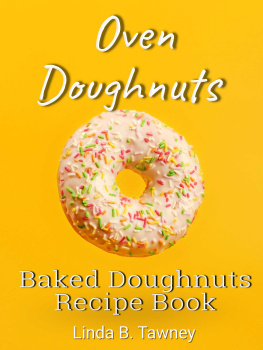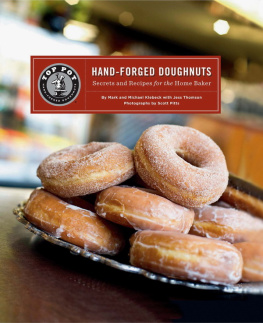 HOMEMADE
HOMEMADE 
DOUGHNUTS
TECHNIQUES AND RECIPES
FOR MAKING SUBLIME DOUGHNUTS IN YOUR HOME KITCHEN
KAMAL GRANT
2014 by Quarry Books
Text Kamal Grant
First published in the United States of America in 2014 by
Quarry Books, a member of
Quayside Publishing Group
100 Cummings Center
Suite 406-L
Beverly, Massachusetts 01915-6101
Telephone: (978) 282-9590
Fax: (978) 283-2742
www.quarrybooks.com
Visit www.QuarrySPOON.com and help us celebrate food and culture one spoonful at a time!
All rights reserved. No part of this book may be reproduced in any form without written permission of the copyright owners. All images in this book have been reproduced with the knowledge and prior consent of the artists concerned, and no responsibility is accepted by the producer, publisher, or printer for any infringement of copyright or otherwise, arising from the contents of this publication. Every effort has been made to ensure that credits accurately comply with information supplied. We apologize for any inaccuracies that may have occurred and will resolve inaccurate or missing information in a subsequent reprinting of the book.
Library of Congress Cataloging-in-Publication Data available
Digital edition: 978-1-61058-890-4
Softcover edition: 978-1-59253-845-4
Digital edition published in 2014
eISBN: 978-1-61058-890-4
Design: Landers Miller Design
Cover Design: Landers Miller Design
All photography by Deborah Whitlaw Llewellyn/www.dwlphoto.com, with the exception of the following: Universal Images Group
(Lake County Discovery Museum)/Alamy, .
Stylist: Annette Joseph/www.ajphotostylist.net
I got into this business because I love sweets. Sweets make people happy, and my culinary career is dedicated to spreading joy and doughnut love
Kamal Grant
CONTENTS
CHAPTER 1
THE HISTORY OF THE DOUGHNUT
CHAPTER 2
DOUGHNUT BASICS: INGREDIENTS & EQUIPMENT
CHAPTER 3
DOUGHNUT-MAKING TECHNIQUES
CHAPTER 4
DOUGHNUT RECIPES
CHAPTER 5
GLAZES AND ICINGS
CHAPTER 6
FILLINGS
CHAPTER 7
ACCOUTREMENTS
CHAPTER 8
AROUND THE WORLD IN DOUGHNUTS
CHAPTER 9
CREATIVE DOUGHNUT COMBINATIONS
The donut is the street thug of the pastry world, strutting past Madeline and clair.
Patrick Kuh, Los Angeles magazine
INTRODUCTION
COMMUNITY IS VERY OFTEN FORMED AROUND FOOD. The simple act of breaking bread with another person can significantly impact the quality of our social interactions. We sit down at the dinner table with our families to share a meal and the details of our days. We have lunch with new colleagues to help create a bond that extends beyond business. And sometimes, we gather around a box of doughnuts at our church, local community center, or workplace conference room to experience a sense of camaraderie and to tackle a project.
Anthropologists have long understood that eating is among the most social acts that people have shared throughout time. As Paul R. Mullins explains in Glazed America: A History of the Doughnut, The moment our earliest hominid relatives gathered at central base camps and began to share food production and consumption was a critical juncture that did not simply ensure our literal survival; the acquisition, distribution, and consumption of food established a social framework within which labor roles, kin relations, and even group identity began to coalesce. But, even as our social structures evolve due to changes in labor and family dynamics, and access to microwavable meals, fast food, and meal delivery servicesall changes that affect the shared experience of meal preparation and consumptiondoughnuts still have a remarkable ability to bring people together. Perhaps this is why they come by the dozen.
So what makes the doughnut so special? When I was growing up, I remember that my mom would bring home Dunkin Donuts to me and my brother as a special treat. There was such excitement around it, as we negotiated (okay, maybe wrestled) over the last twisted yeast doughnut. I dont remember anyone at the time making doughnuts at home. Making doughnuts can be a lot of work, and with the rise of chains such as Dunkin Donuts and Krispy Kreme, access to doughnuts became easy and inexpensive, and a simple way to bring joy to any occasion. Years later, in my high school home economics class, my teacher would show us how to make monkey bread, a messy collection of dough covered with cinnamon and sugar and baked. Being a sweet lover, I was hooked. I later experimented with frying canned biscuit dough at home to make my first doughnutsthe beginning of my fascination with the pastry.
Making doughnuts at home can be a cumbersome undertaking for the novice baker and even though my livelihood is based on people like you coming to my shop, Sublime Doughnuts, it behooves me as a fan and passionate advocate of this pastry (the thug of the pasty world) to share my knowledge and experience to help you create these sublime treats in your own home. I got into this business because I love sweets. Sweets make people happy, and my culinary career is dedicated to spreading joy.
I encourage you to use this book as a guide to understand the building blocks of baking science. Once you master the basic techniques and recipes, you will be creating your own unique flavors to share with family and friends.
Thanks for spreading doughnut love!
Officers at a USO club ca. 1942 enjoying doughnuts, USA, A Home Away from Home USO club operated by the Salvation Army
The sight of all those doughnuts marching solemnly to their fate makes me proud to be an American.
Nora Ephron, on her visit to New Yorks first Krispy Kreme franchise
CHAPTER 1
THE HISTORY OF THE DOUGHNUT
DOUGHNUTS HAVE A RICH HISTORY in almost every culture since the beginning of time. As soon as people were able to fry dough, they began making their own variations. Olive oils, animal fats, and other vegetable oils would have been suitable for frying grains, and a vast range of places can make a claim to early fried treats, says anthropologist Paul R. Mullins in Glazed America: A History of the Doughnut. From fried dough balls dusted with powdered sugar in the Horn of Africa to fried dough soaked in yogurt and sprinkled with vegetables and spices in India, Mullins explains, All of the sweet fried pastries that emerged throughout the world are relatives to the doughnut, but they are distinguished by shape, seasonings, ingredients, or preparation techniques. The northern Mexican pastry knows as the sopapilla, for instance, is a flat flour crescent that can accompany a meal or be a dessert when garnished with honey, powdered sugar, or cinnamon.
The actual term doughnut is believed to have been first written by Washington Irving in his 1809
















 HOMEMADE
HOMEMADE 